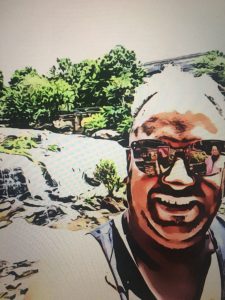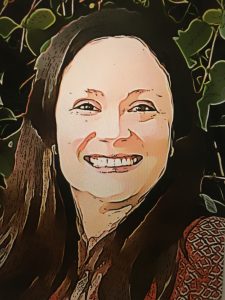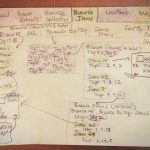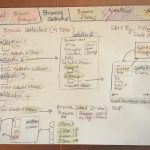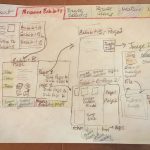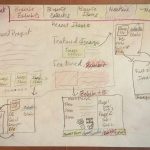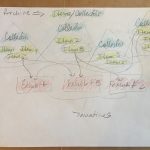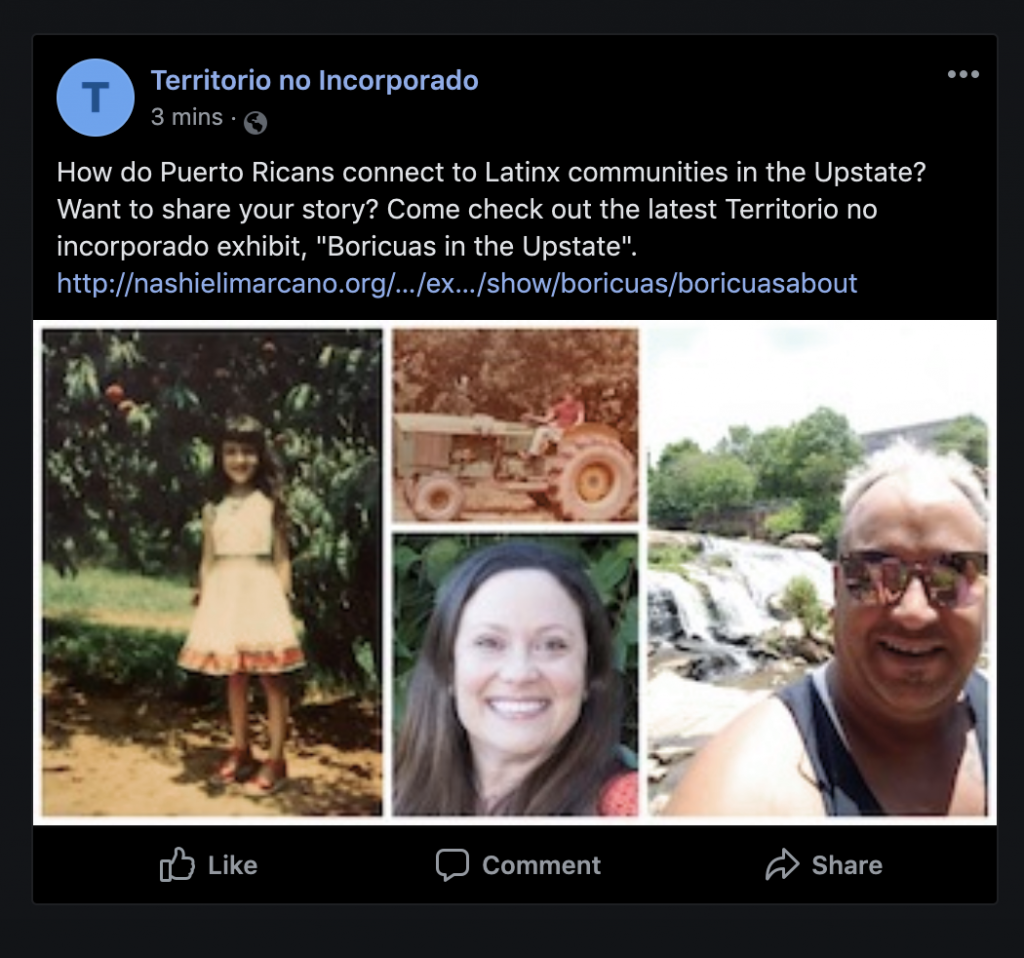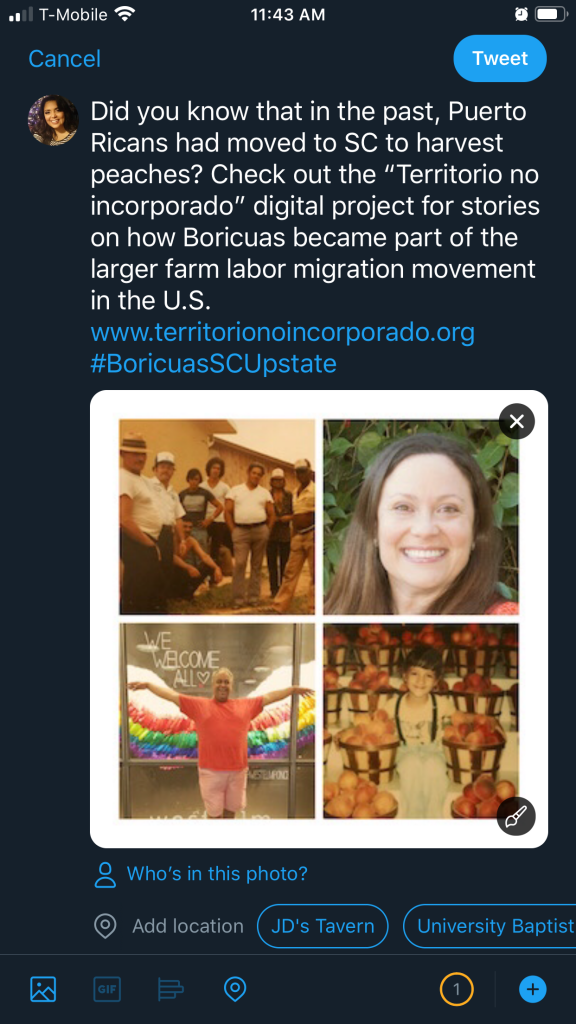Introduction
“Territorio no incorporado” is a small-scale, digital public history prototype developed to showcase the experience of Puerto Ricans in the Upstate region of South Carolina. Powered by Omeka, this site has been an invitation for DPH newbies like me to get a firm handle on the how to build a website, select and create primary sources, organize items into collections, and present them through exhibits. The following is a reflection on my process of building this prototype and the lessons I learned throughout the different stages of this course.
Defining Public History
Through the introductory phase, the reading materials provided me with the foundation for conceptualizing my project. It was critical to define the concepts of publics and history, and learn about how other digital public historians have facilitated audience-content creation and engagement. I was able to have more informed projections of how potential “Territorio no Incorporado” users can make use of digital tools and platforms for exploration and discovery. The hardest challenge during this period was striking the balance between providing an un-mediated platform for user-generated content, and guiding users to richer forms of content creation and meaning.
Surveying the Landscape
Once I have devised a quasi-sustained pathway to collaborative content creation and discovery, it was time for me to visualize the landscape I was about to create and enter. There were two class activities that provided me with opportunities to survey fields: doing a comparative review of two public history sites, and evaluating a mobile DPH site. The first activity, which was complemented by secondary sources on public historical site review guidelines, taught me a great deal about how museum exhibits (1) present historical arguments, (2) select the appropriate content to communicate their interpretive argument, (3) design their navigation and traffic flow layouts, (4) incorporate participatory and interactive elements to the experience, and (5) introduce personnel to their exhibits spaces. Comparing the physical exhibit to the virtual one, afforded me with the insight to all the technical and methodological considerations I need to make in order to pitch my project idea to stakeholders.
The Creation of Personas
Appreciating the interview as a tool to initiate the shared-authoring process became an effective way for me to get to know audience members, to pay a closer attention to their wants and needs. As part of the design of the “Territorio no Incorporado” prototype, I was able to collect data from two interviews conducted with Puerto Ricans living in the Upstate region. Collecting information related to work routines, leisure activities, traveling rituals (including historical site visits), and their levels of engagement with online platforms, painted a better profile of potential visitors to “Territorio no incorporado”.
User research findings led to the creation of personas, which served as my guide to simulate an audience-centered design experience, and to develop effective more measures for projecting content-user relationships. I knew from these personas, that I needed to create a platform that works with mobile devices and tablets, and that incorporates social media channels for higher levels of engagement.
Collections & Narrative Interpretations
Drafting Social Media & Project Evaluation Plans
Based on the personas I developed and on the source types collected and curated, the social media platforms I considered to work alongside “Territorio no incorporado” are Facebook and Twitter would help me: (1) foment interest in learning more about the Puerto Rican experience in the Upstate region of South Carolina, (2) engender interactions between users and the digitized collections of images, (3) direct traffic to the site, and (4) inspire audiences to share stories of their own or develop an interest in engaging with further scholarly reading.
Drafting this plan was an opportunity for me to conduct further audience research, and to gain deeper appreciation for what it takes to have a sustainable strategy. I understand that to make this a successful endeavor, it would require time and additional personnel to perform the following functions:
- create postings
- schedule postings
- follow up with comments made by viewers
- adopt metrics to measure success
- be consistent with points 1-4
Perhaps the most encompassing phase during this process was the drafting of a site evaluation plan. It was an incredible exercise that forced me to constantly think about the “so what” of this project and about all the possible considerations that one must be take in order for this project to take off and stay alive. This draft (as imperfect as it was), was to establish outcome goals, and for each goal, I was to determine assets/resources, activities, audience, indicators of success, and long-term impacts. Wow! This was truly a reflective activity that put my project idea on a different level of thinking: from the most granular aspects (e.g. lesson plans) to the most comprehensive projections. After doing this activity, I wish I had come back to the social media strategy assignment and redo it, as I felt it came short.
Peer Reviewing and Audience Feedback
The “Territorio no incorporado” site was reviewed by two audience members from the Puerto Rican community in the Upstate. Here are my reviewers’ comments:
“OK. the experience very informative and exceeded my expectations, especially, the information about Julio and Maria engaging in civic duty. Content-wise, I thought it was thorough, but when comparing Julio’s story to Maria’s, not much is said about Maria.”
“Overall impression- super engaging. The videos and audio make it fun and dynamic. Easy to navigate. You have done a fantastic job with this project.”
The peer review session was very insightful, not just in the role of the one being reviewed, but also as a reviewer of other projects. It was wonderful to see where my peers have taken their projects, as well as their methodologies, and application of techniques. The subjects were interesting, and some of the source types curated were so well done. The review I received, in many ways, confirmed some of the successes I had with the variety of primary source types I was able to curate, as well as some of the issues I encountered regarding my audience. A better defined audience would have yielded better interpretive content, which in turn, would have increased levels of interaction.
Pitch Video
A video has been created to introduce users to the “Territorio no incorporado website”. I’m currently looking for a way to incorporate this onto the About page of the site, but have not yet succeeded. I used Camtasia for the creation of this product. Although fun to do, it became a product that, once again, revealed my successes and challenges. Very reflective in nature.
Lessons Learned
Think like a public historian-Posing historical questions early on that matter to the public, not just to a scholar, would have helped me create more appropriate interpretive content.
Approach the project with the audience perspective in mind- Some of the best content was created thanks to contributors’ suggestions
Dont’ overpromise- I really wanted to play with Neatline and other mapping tools to represent the networks of relationships I envisioned for the project.
I can do this!…but not by myself- It feels amazing to see how much progress I’ve made in playing with digital tools and creating a digital public history prototype. I figured out my strengths, as well as aspects I need to further develop. But not alone, these DHP endeavors are possible only when working collaboratively.
